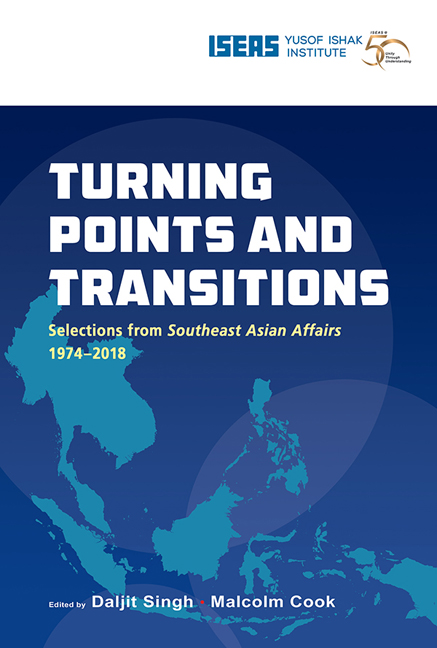Book contents
- Frontmatter
- Contents
- Message from the Director
- Foreword
- Foreword
- Introduction
- THE REGION
- BRUNEI
- CAMBODIA
- INDONESIA
- LAOS
- MALAYSIA
- MYANMAR
- THE PHILIPPINES
- SINGAPORE
- THAILAND
- The Revolutionary Situation in Thailand (1975)
- American Military Withdrawal from Thailand (1976)
- The Thai Economy: From Boom to Gloom? (1997)
- Thailand: A Year of Diminishing Expectations (1999)
- Thailand: A Reckoning with History Begins (2007)
- What Went Wrong with the Thai Democracy? (2015)
- VIETNAM
The Thai Economy: From Boom to Gloom? (1997)
from THAILAND
Published online by Cambridge University Press: 29 May 2019
- Frontmatter
- Contents
- Message from the Director
- Foreword
- Foreword
- Introduction
- THE REGION
- BRUNEI
- CAMBODIA
- INDONESIA
- LAOS
- MALAYSIA
- MYANMAR
- THE PHILIPPINES
- SINGAPORE
- THAILAND
- The Revolutionary Situation in Thailand (1975)
- American Military Withdrawal from Thailand (1976)
- The Thai Economy: From Boom to Gloom? (1997)
- Thailand: A Year of Diminishing Expectations (1999)
- Thailand: A Reckoning with History Begins (2007)
- What Went Wrong with the Thai Democracy? (2015)
- VIETNAM
Summary
Following elections in November 1996 a new coalition government took office in Thailand, led by incoming Prime Minister and New Aspiration Party leader General Chawalit Yongchaiyut. The new administration began its work in an atmosphere of great concern about the state of the Thai economy. Throughout 1996 Thai economic commentary was dominated by signs that the export-led boom that began in the late 1980s may be coming to an end. Most important of these signs were an apparently dramatic slow-down in the annual rate of growth of total exports and revelations that some investment and securities institutions may be unable to meet interest obligations. Confidence in Thailand's capacity to sustain high levels of economic performance was seriously damaged. The economic situation had clearly contributed to the downfall of the previous government of Banharn Silpa- Archa and posed immediate dangers for the new government. Identifying the causes of these and other economic problems is the central theme of this article.
Economic Boom, 1988–95
The background to the economic gloom of 1996 was the unprecedented boom which began in 1988. Over the eight years ending in 1995 the Thai economy was the fastest growing in the world (Table 1). The average rate of real GDP growth was unprecedented, at 10.4%, and inflation was low, averaging 5.3%. Two factors produced the dramatic growth: growth of exports, especially exports of labour-intensive manufactured goods; and very high inflows of foreign capital, including direct foreign investment. The two went together, in that much of the foreign investment was in the labour-intensive manufacturing sector. Export growth over this period averaged an extraordinary 28% per annum and as a share of GDP exports surged from 23% in 1988 to 34% in 1995. Economic inequality increased during this period but this should not be taken to mean that the benefits of growth were confined to the rich. The boom coincided with dramatically reduced incidence of absolute poverty, which fell from 22% in 1988 to under 10% in 1994, using the most common definition of poverty incidence.
Economic Gloom, 1996
In 1996 GDP growth in real terms fell to “only” 6.8%, the first year since 1993 of annual growth below 8%. Inflation was moderate at just under 6%.
- Type
- Chapter
- Information
- Turning Points and TransitionsSelections from Southeast Asian Affairs 1974-2018, pp. 649 - 664Publisher: ISEAS–Yusof Ishak InstitutePrint publication year: 2018

